26.06.2023
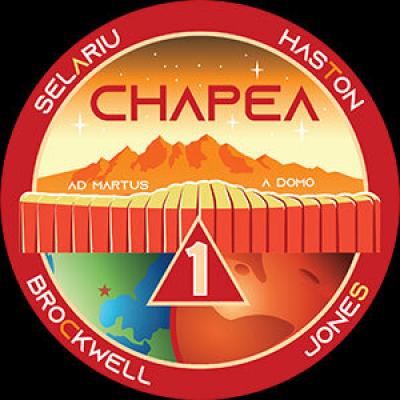
The next time that Kelly Haston, Ross Brockwell, Nathan Jones and Anca Selariu will see blue sky, a year will have gone by on Earth.
Not that the four "analog astronauts" are leaving the planet, but for the next 12 months they will live inside a mock Mars base located at NASA's Johnson Space Center in Houston, Texas, where they will be remotely observed and studied by scientists. As the first of three planned Crew Health and Performance Exploration Analog, or CHAPEA, crews, Haston, Brockwell, Jones and Selariu will help inform the space agency how to better design and plan for future human missions on the real Martian surface.
Mission 1 gets underway tonight (June 25) as the four volunteers enter the 1,700-square-foot (158-square-meter) habitat, known as "Mars Dune Alpha," at 7:30 p.m. EDT (2330 GMT). They will not leave the 3D-printed structure — other than to conduct the occasional Mars-walk within an adjoining 1,200-square-foot (111-square-meter), enclosed Mars "sandbox" — until Sunday, July 7, 2024.
"To me, this is really exciting because one of the things that's different than some of our previous analogs at NASA is people will be in isolation as a crew for 378 days," Suzanne Bell, lead for NASA's Behavioral Health and Performance Laboratory at Johnson Space Center, said in an interview with collectSPACE. "We also do analogs in something called HERA, the Human Exploration Research Analog, and our missions there have been 45 days. And then we collect data at other analogs, too, with varying lengths, but this will be three, over one yearlong missions, which is a really great extended isolation."
The crew was selected to be "astronaut-like," according to Bell, with a requirement that they have a degree in one of the STEM (science, technology, engineering and mathematics) fields, as well as professional experience in their chosen field, piloting experience or military training. They also had to pass the same physical and psychological testing as astronaut candidates to ensure they were fit for the program.
Haston, a research scientist studying human disease, is the mission's commander. Brockwell, a structural engineer, is the crew's flight engineer. Jones is the medical officer, pulling on his experience an emergency medicine physician, and Selariu, a microbiologist in the U.S. Navy, is science officer.
Selariu was originally selected to be a back-up crew member, but replaced Alyssa Shannon, an advanced practice nurse, prior to the mission starting. NASA did not provide an explanation for the change.
Haston, Brockwell, Jones and Selariu will not only have to survive living together for more than a year, but also adjust to some of the same changes that a crew on Mars would face.
"What CHAPEA is really about is Mars-realistic conditions in terms of resource restrictions, so isolation confined with the living space being one of them," said Bell. "But we're also restricting the crew to a spaceflight food system. time delayed communications, mission-relevant timelines, contingency situations and other resource restrictions."
A mission control and safety console will be staffed at all times, but messages from Mars Dune Alpha will take 22 minutes to be received, the same time it would take for a call from Mars to reach Earth. And the crew will be eating freeze-dried, thermostablized and shelf-stable foods, but as they are not simulating Martian gravity (38 percent of the surface gravity on Earth), they will be saved from using a special toilet.
The crew will also remain on Earth-time, counting days (24 hours) rather than sols (approximately 24 hours, 39 minutes, 35 seconds).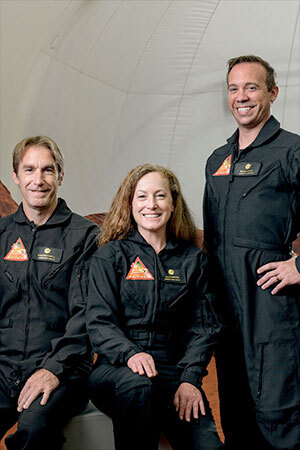
NASA's Crew Health and Performance Exploration Analog Mission 1 (CHAPEA Mission 1) crew are ready to spend more than a year "on" Mars. From left to right: Ross Brockwell, flight engineer; Kelly Haston, commander; and Nathan Jones, medical officer. (Science officer Anca Selariu is not pictured.) (NASA)
"My understanding of the research we've looked at so far with the Mars sol is that expected impacts would be heavily on Mission Control," Bell said, "while our focus for this particular analog is the impact on the crew and their human health and performance."
Otherwise, the CHAPEA crew will live for the next year as though they were really on Mars, taking part in the same kinds of activities that astronauts on the red planet would do. They will be instructed by Mission Control to perform science investigations, perform maintenance work on the habitat and maintain their fresh food crops.
They may also encounter periodic, unexpected problems to see how they react. What those additional "stressors" might be, Bell is not saying.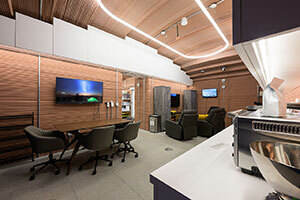
Inside Mars Dune Alpha, a 3D-printed mock Mars base at NASA's Johnson Space Center in Houston, Texas. (NASA)
"If I told you that it wouldn't be a surprise," she told collectSPACE. "A lot of our focus is simply with resource restrictions. So if people don't get to choose what's on their menu, how does that affect their health? Those are the types of things we're focused on for this series of missions. That will be a great baseline for us to then continue to explore all of these different possibilities of ours."
Quelle: CS
+++
Meet the 4 strangers who will live on ‘Mars’ for a year in NASA’s Johnson Space Center in Houston
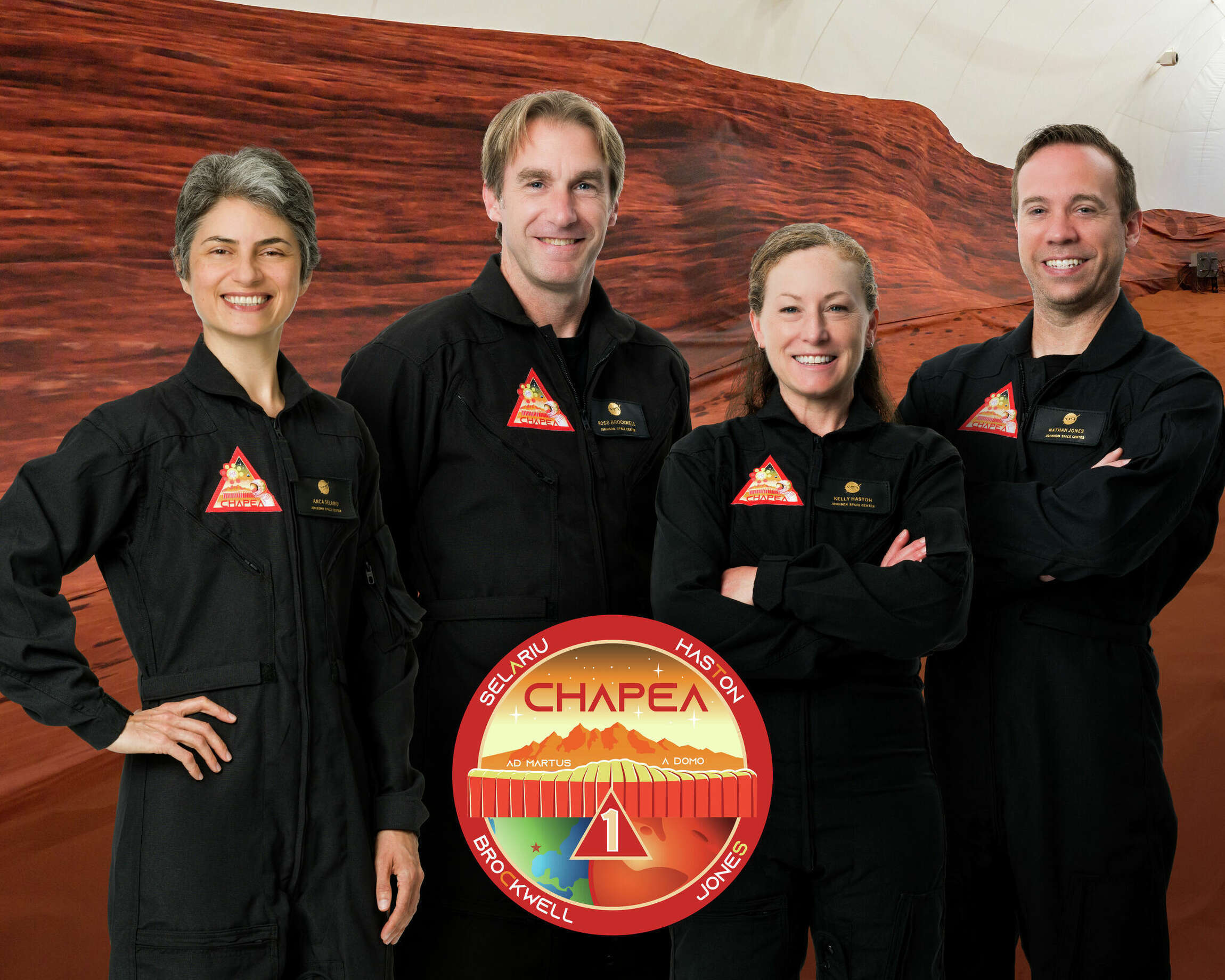
This image shows the four individuals who will spend a year living in a Mars simulation at NASA's Johnson Space Center. From left are crew members Anca Selariu, Ross Brockwell, Kelly Haston and Nathan Jones. Their individual photos have been stitched together and placed onto a background of their Mars habitat.
NASA
Nathan Jones wondered if his family could play Uno with an up to 22-minute communications delay — each way.
Ross Brockwell convinced a lifelong friend to manage his miscellaneous affairs, and Kelly Haston stockpiled videos of friends and family.
These three strangers — plus Anca Selariu, a backup crew member who was added to the mission on Tuesday — will spend 378 days pretending to be on Mars. They will embark on that journey Sunday around 7 p.m.
A YEAR ON FAKE MARS: Johnson Space Center hangar to stand in for the Red Planet
The crew will live in a 1,700-square-foot habitat at NASA’s Johnson Space Center. Its reddish-brown walls look as if they were made from Martian dirt. There’s an additional 1,200-square-foot sandbox for when the crew ventures “outside.”
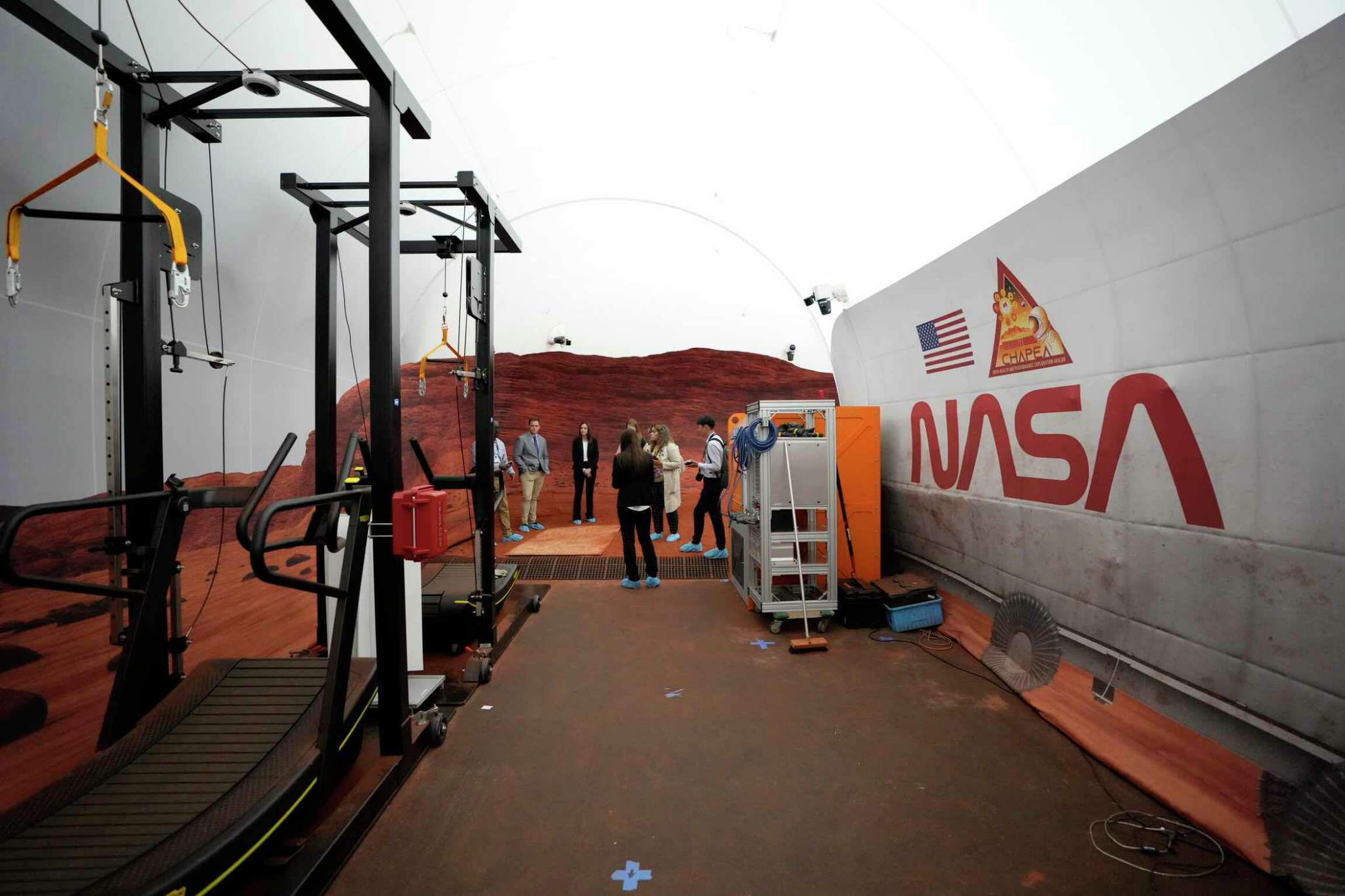
The sandbox is shown in the "Mars" facility where four people will live and work for a year inside NASA's Johnson Space Center on Tuesday, April 11, 2023, in Houston.
Melissa Phillip/Staff Photographer
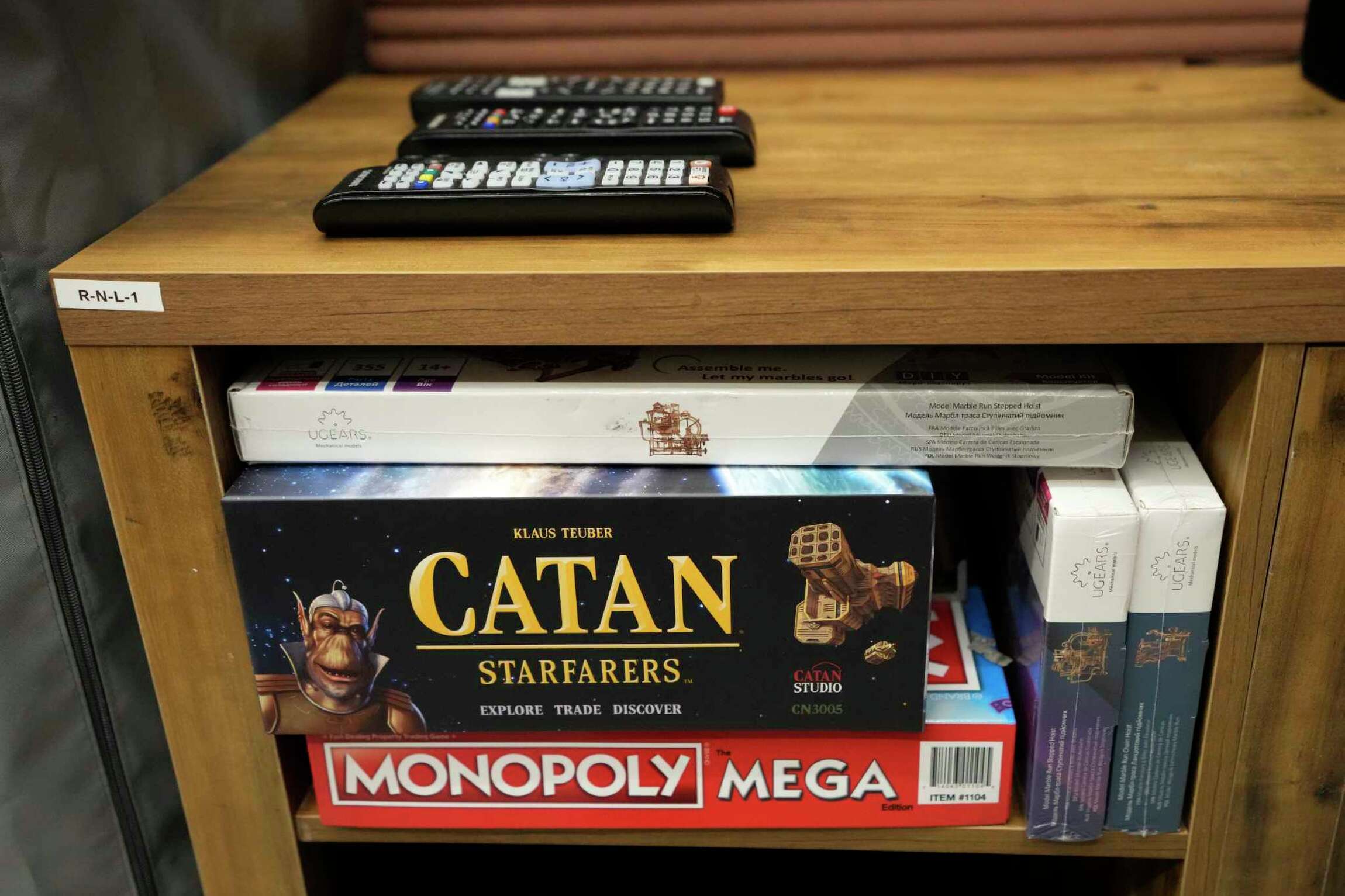
A selection of board games in the living area of the habitat where four people will live and work for a year inside NASA's Johnson Space Center on Tuesday, April 11, 2023, in Houston.
Melissa Phillip/Staff Photographer
They will live as if they’re actually on the Red Planet. The crew members will have an exercise regimen to stay healthy. They will have restrictions on how much water they can use for showering. Their food will be shelf stable, and communication with loved ones could be intermittent.
All of this is to help NASA identify and remedy the physical, mental and social challenges that could arise when living on another planet. It’s better to observe how such stressors affect a crew on Earth than when astronauts arrive on Mars for the first time.
“It’s definitely going to be challenging,” Brockwell said, “but that’s why we’re doing this. How we learn to cope with that is some of the most important information they’re going to get out of this study.”
Overall, the crew members were most worried about the isolation from friends and family. They weren’t as worried about the shower restrictions or food.
Haston, a research scientist in Pacifica, Calif., who has experience building models of human disease, is an ultra runner (she runs beyond a marathon’s 26.2 miles) and a backpacker. She’s also done fieldwork in Africa.
“I’m a fan of rugged endeavors,” Haston said. “I’m also not food oriented, which disappoints all of my foodie friends and my partner. Left to my own devices, I will actually eat the same thing a lot.”
It was her longtime partner Elliot Mount who told her about the Mars analog. He knew Haston would relish the challenge of living in a limited environment. He also knew she was intrigued by the idea of solving problems in a space environment — she’s adamant that NASA innovations don’t just benefit space travel.
“How do we grow plants in a limited environment? How do we deal with extreme environments?” Haston asked. “Those types of things are really very interesting and may lead to innovations that help us even earlier than leaving, you know, being on Mars.”
Haston left her job at a drug development startup for the Mars simulation. She’ll likely check back in after her mission. In the meantime, NASA is paying the participants $10 per hour for all waking hours, up to 16 hours per day. That’s as much as $60,480 for the 378-day mission.
Jones, an emergency medicine physician from Springfield, Ill., grew up in the country and said he’s used to bad water pressure or a well running dry. But he does worry about spending a year away from his three kids, Micah, 13, Owen, 11, and Ezra, 8.
“Something’s going to break at my home with my family, like the lawnmower or something, and I’m not going to be there to fix it,” he said. “I think it’s going to be easy to get homesick when that happens.”
But it’s a once-in-a-lifetime experience, and Jones felt the job was made for him. His background working outside of hospital settings where resources are slim — he’s been a flight physician, led medical mission trips to Central America and volunteered on a SWAT team to provide care during mass shootings — felt like a good fit for working with the restrictions on Mars.
Brockwell, a structural engineer and public works administrator from Virginia Beach, Va., had previously applied to be a NASA astronaut. When news broke about the Mars study, friends quickly sent him the application.
“I thought it was a really exciting opportunity to participate in the space program and the Mars mission in particular,” he said. “It’s always been an interest of mine and a dream of mine.”
The crew’s habitat was 3D-printed by Austin-based Icon. In the future, the company is looking at adapting its cement-based 3D printing for Mars. The building material could be created with Martian soil — and Brockwell finds this particularly fascinating.
Selariu, a microbiologist in the U.S. Navy, joined the primary crew just days before the mission was set to begin. She had been in Houston since late May training alongside the primary crew. NASA did not say why the former primary crew member, Alyssa Shannon, wouldn’t be participating in the mission.
Haston, the mission’s commander, is excited to see how the crew members’ bonds develop and change over the year. And even though they won’t be working with real Martian rocks and science, these four individuals will be conducting the type of science that could be done on Mars — and with the same type of stressors.
“Being a scientist and also the test subject is actually a really unique and cool position to be in,” she said.
Quelle: Houston Chronicle
